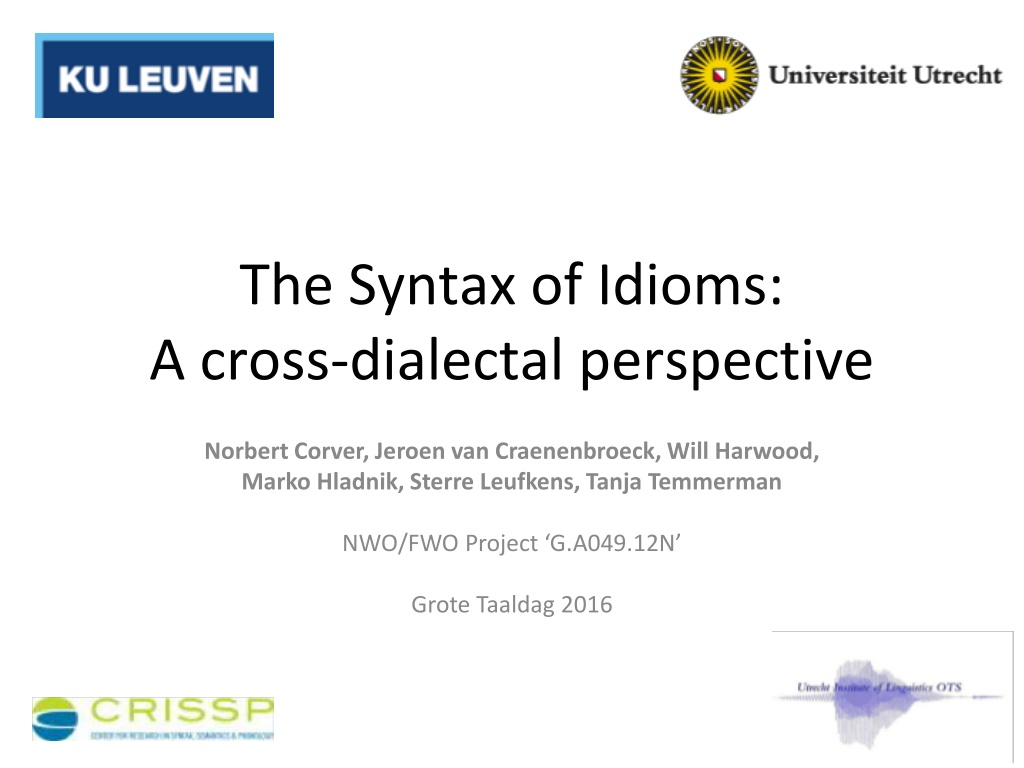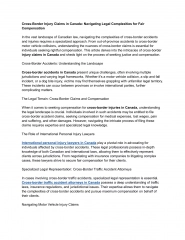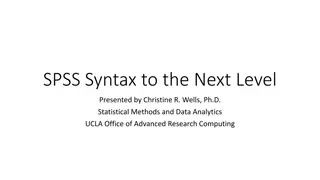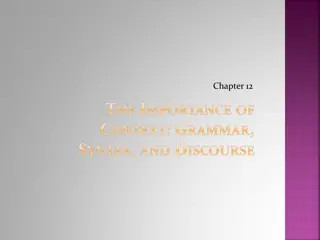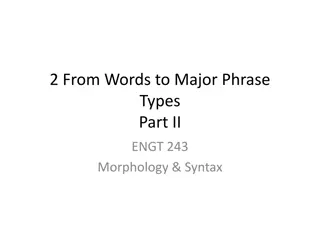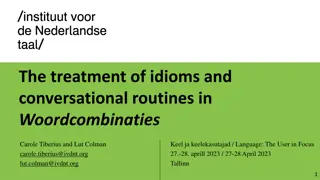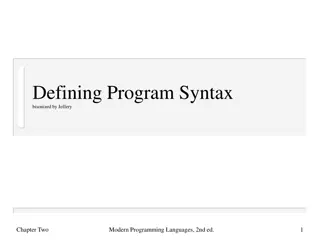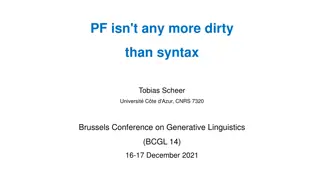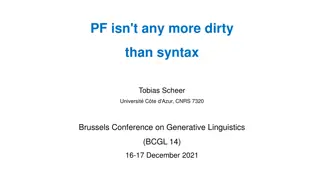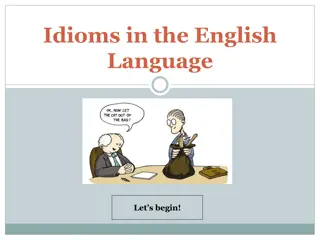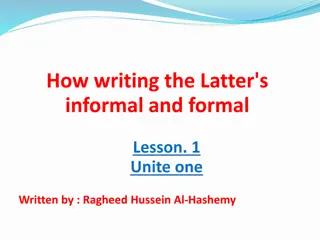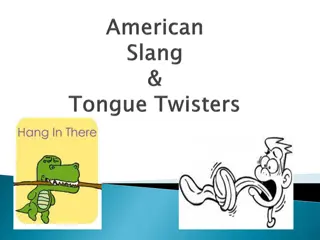Exploring the Syntax of Idioms: A Cross-Dialectal Study
Delve into the intricacies of idiomatic expressions through a cross-dialectal perspective, examining both internal and external syntax, and criteria for identifying verbal idioms. Researchers investigate the regular syntactic rules governing idiomatic structures and their interaction with non-idiomatic language elements.
Download Presentation

Please find below an Image/Link to download the presentation.
The content on the website is provided AS IS for your information and personal use only. It may not be sold, licensed, or shared on other websites without obtaining consent from the author.If you encounter any issues during the download, it is possible that the publisher has removed the file from their server.
You are allowed to download the files provided on this website for personal or commercial use, subject to the condition that they are used lawfully. All files are the property of their respective owners.
The content on the website is provided AS IS for your information and personal use only. It may not be sold, licensed, or shared on other websites without obtaining consent from the author.
E N D
Presentation Transcript
The Syntax of Idioms: A cross-dialectal perspective Norbert Corver, Jeroen van Craenenbroeck, Will Harwood, Marko Hladnik, Sterre Leufkens, Tanja Temmerman NWO/FWO Project G.A049.12N Grote Taaldag 2016
Outline Introduction of research project The syntax of idioms The internal syntax of idioms: what do we know, what do we think, what have we found so far? The external syntax of idioms: what do we know, what do we think, what have we found so far? What do you think? 2
The syntax of idioms NWO/FWO funded project (2013-2017) Cooperation of KU Leuven (external syntax) & University of Utrecht (internal syntax) Current team: Norbert Corver (Utrecht) Jeroen van Craenenbroeck (Leuven) Will Harwood (Leuven) Marko Hladnik (Utrecht) Sterre Leufkens (Utrecht) Tanja Temmerman (Leuven) 3
What is an idiom? an idiom = an expression whose meaning is not predictable from (the combination of) the literal meanings of its parts kick the bucket = die de bloemetjes buiten zetten = to go out and celebrate/party (cf. English 'paint the town red ) 4
The focus of the project: verbal idioms Criteria to identify a true verbal idiom (cf. Marantz 1984; Kiparsky 1987; Fillmore et al. 1988; Nunberg et al. 1994; Croft & Cruse 2004; Svenonius 2005; Evans & Green 2006) it must contain a lexical verb ( the big cheese) it must have a non-literal interpretation ( shoot a man) it must be comprised of lexical items that are found outside of the context of the idiom ( hoisted by one s own petard) it must be able to interact with productive syntax ( Is the Pope Catholic?) it must be formed in a manner which obeys the regular syntactic rules of the language ( be that as it may) 5
Research questions General research question: What is the syntax of idioms? Divided into 2 sub-questions: 1.What is the internal syntax of idioms? What characterizes their internal organization and makeup? Hypothesis: the internal syntax of idioms is built up through the same regular, compositional structure building mechanisms that create non-idiomatic structures. 2.What is the external syntax of idioms? How does material contained within the idiom interact with material external to the expression? Hypothesis: idioms represent opacity domains. Their - sometimes varying - degree of opacity can be reduced to the known opacity domains (cf. phases, workspaces, ellipsis domains). 6
The syntax of idioms Idioms in the literature mostly English small set of poster child idioms authors make claims on transparency, compositionality and syntactic flexibility of idioms based on single-speaker judgments -- there is no systematic study often concerned primarily with the lexical content of idioms 7
The syntax of idioms Our project Focus on functional projections Standard Dutch + 13 Dutch dialects Cross-dialectal differences in syntax may result in cross- dialectal differences in idioms (e.g. Warffums) Analyzing idioms from available dialect dictionaries Acquiring grammaticality judgments on syntactic manipulations of idioms, so as to systematically test syntactic flexibility 8
The syntax of idioms Fieldwork methodology Collect idioms from dialect dictionary Ask native speaker to select those idioms that are well-known/frequently used Compile questionnaire with syntactic manipulations of idioms Interview informants 10
The syntax of idioms Part 1 of the questionnaire: manipulations of internal syntax Definiteness, demonstratives, possession, quantification, modification Part 2 of the questionnaire: manipulations of external syntax Topicalization, Voice, Tense, Aspect, Modality Fillers & controls 11
The syntax of idioms Database two (sub)parts: (a) idioms collected from dialect dictionaries + their syntactic properties, (b) selected idioms in the 14 varieties + judgments on their syntactic flexibility (min. 6 speakers per dialect) allows for the presentation of gathered data and facilitates searches will be made available online 12
The internal syntax of idioms: what we know The internal morphosyntax of idioms appears to be no different from that of non-idiomatic expressions, in the sense that both types are built by the same abstract mechanisms (cf. Fellbaum 1993, Nunberg et al. 1994, Ifill 2002, Svenonius 2005, a.o.) What, then, gives rise to idiomatic interpretation? 13
The internal syntax of idioms: what we know Zooming in at the DP structure in V-DO idioms, we will explore the role of its functional layer Main idea: The use of a definite determiner in unexpected contexts is a contributing trigger for idiomaticity Unexpected in what way? To be discussed next. 14
The syntax of idioms Distinction to keep in mind (Nunberg et al. 1994): Idiomatically Combining Expressions (ICEs) (spill the beans) Elements of the literal expression can be mapped onto elements of the figurative meaning The DP actually has a referent; beans = secret; the noun is used metaphorically and collocates with a particular verb Idiomatic Phrases (IdPs) (kick the bucket) the expression as a whole is mapped to the figurative meaning ICEs are syntactically flexible, IdPs are not. 15
The internal syntax of idioms: what we know In ICEs, the use of determiners is predictable, can be either definite or indefinite, depending on the referential properties Definite: the entity referred to has been pre-established in the discourse, is inferable from general knowledge, or is unique, etc. John spilled the beans (about his girlfriend) #John spilled the beans that his girlfriend worked for the CIA. Indefinite: introduces a new referent to the discourse have a bone to pick (with someone) 16
The internal syntax of idioms: what we think An additional use of the definite determiner in Idiomatic phrases ( proper idioms ) (cf. Fellbaum 1993, also Gregoire 2009) there is no referent at all, the use of a definite determiner is therefore not prototypical, but unexpected and triggers an idiomatic interpretation kick the bucket, chew the fat, bite the dust, shoot the breeze Less flexible #As for the bucket, John kicked it last week. Idiomatic meaning disappears when the definite determiner is replaced by an indefinite one #John kicked a bucket. 17
The internal syntax of idioms: what we find Relation between referent availability and syntactic flexibility ne metten schieten (lit. to shoot a young calf, to make a mistake ) (Aalst) referent available (mistake), allows for change of determiner, modification Ieder joor op da congres schiet Piet ne metten, mor deis joor schoet Jan de metten. A schiet ne gral ke metten. ('he made an enormous mistake ) 18
The internal syntax of idioms: what we find Relation between referent availability and syntactic flexibility de melk optrekken ( go back on the promise ) (Deventers) referent available (promise), allows for topicalization and modification Jazeker, de melk wordt deur hem altied opgetrokken! De politicus trok de beloofde melk op. 19
The internal syntax of idioms: what we find Relation between referent availability and syntactic flexibility de Battemse krante l zen ( to sleep/nap ) (Deventers) no referent, inflexible #Ja zeker, de Battemse krante leest hee elke dag! #Hee las de hele Battemse krante. #Hee las een Battemse krant 20
The internal syntax of idioms: what we think Idiomatic phrases, of course, also have a literal interpretation, with a referential, definite object The same string thus has two interpretations could there be two distinct syntactic structures underlying them? 21
The internal syntax of idioms: what we think One possibility: Less structure, the DP layer is not projected No DP no phase, these idioms don t straddle phase boundaries The determiner is the spell out of little n, not contributing any definiteness The nP forms a complex, one-place predicate with the verb If APs are adjoined at the DP level (cf. Schoorlemmer 2009), this explains the impossibility of adjectival modification in idiomatic phrases 22
The internal syntax of idioms: what we think Alternatively: differences in projection & labelling (Chomsky 2011) N is not modified merging two heads, D and N Non-idiomatic reading: regular DP, compositional, syntactically flexible Idiomatic reading: N projects! 23
The internal syntax of idioms: what we think The definite determiner in these idioms is semantically vacuous: no referentiality established as the syntactic object is an NP Again, No DP no phase The NP forms a complex, one-place predicate with the verb No place for adjectives: if you merge a head and a phrase (NP), the head will always project 24
The internal syntax of idioms: what we think A parallel to explore: Weak Definites (Aguilar-Guevara & Zwarts 2010, a.o.) only in object position no unique, concrete referent, limited capacity to establish discourse referents Lola listened to the radio until she fell asleep. #She turned it off when she woke up in the middle of the night. restricted when it comes to modification #Lola went to the new hospital. restricted when it comes to altering number Sally read the newspaper vs. Sally read #the newspapers How close can we bring idioms and WD in a common analysis? 25
The external syntax of idioms: what we know Chomsky (1980, 1981); Marantz (1984): verbal idioms - verbal predicate and its arguments vP VP 26
The external syntax of idioms: what we know Chomsky (1980, 1981); Marantz (1984): verbal idioms - verbal predicate and its arguments Verb + DP-theme vP VP kick the bucket 27
The external syntax of idioms: what we know Chomsky (1980, 1981); Marantz (1984): verbal idioms - verbal predicate and its arguments Verb + DP-theme vP VP pull strings 28
The external syntax of idioms: what we know Chomsky (1980, 1981); Marantz (1984): verbal idioms - verbal predicate and its arguments Subject + VP vP the shit VP hit the fan 29
The external syntax of idioms: what we know Chomsky (1980, 1981); Marantz (1984): verbal idioms - verbal predicate and its arguments Subject + VP vP all hell VP broke loose 30
The external syntax of idioms: what we know None of these idioms are dependent on anything outside of the vP domain. vP VP 31
The external syntax of idioms: what we know Kitagawa (1986); Ifill (2002); McGinnis (2002); Svenonius (2005): whilst material in the TP domain - i.e. tense, modality, aspect, voice - can embed idioms, idiomatic interpretations are never be dependent on such material: (7) He is bringing down the house. [Prog] (8) He brings down the house every evening. (1) He spilt the beans. [Tense] (2) He often spills the beans. (3) He might kick the bucket. [Mod] (4) He kicked the bucket. (9) Strings were pulled. [Voice] (10) He has been pulling strings. (5) The shit has hit the fan. [Perf] (6) The shit hit the fan. 32
The external syntax of idioms: what we know Svenonius (2005): there is a size limitation to idioms: Idioms are comprised of material from the vP domain. Idioms cannot be comprised of material from the TP domain. Svenonius (2005): verbal idioms correspond to the clause-internal phase: Idioms can be smaller than or equal to the vP phase boundary. Idioms cannot be larger than/straddle the vP phase boundary. 33
The external syntax of idioms: what we know Intuitive: phases shipped off independently to PF and LF Idiomatic interpretation accessed at LF Syntactic chunk cannot be idiomatically interpreted if part of idiomatic material is external to the vP phase and so is left stranded in the syntax 34
The external syntax of idioms: what we know Intuitive: phases shipped off independently to PF and LF Idiomatic interpretation accessed at LF Syntactic chunk cannot be idiomatically interpreted if part of idiomatic material is external to the vP phase and so is left stranded in the syntax vPprog Prog Phase vP VP 35
The external syntax of idioms: what we know Intuitive: phases shipped off independently to PF and LF Idiomatic interpretation accessed at LF Syntactic chunk cannot be idiomatically interpreted if part of idiomatic material is external to the vP phase and so is left stranded in the syntax vPprog Prog Phase vP VP Idiom item Idiom item 36
The external syntax of idioms: what we know Intuitive: phases shipped off independently to PF and LF Idiomatic interpretation accessed at LF Syntactic chunk cannot be idiomatically interpreted if part of idiomatic material is external to the vP phase and so is left stranded in the syntax vPprog PF Prog Phase vP LF Idiomatic interpretation VP Idiom item Idiom item 37
The external syntax of idioms: what we know Intuitive: phases shipped off independently to PF and LF Idiomatic interpretation accessed at LF Syntactic chunk cannot be idiomatically interpreted if part of idiomatic material is external to the vP phase and so is left stranded in the syntax vPprog Prog Phase vP Idiom item VP Idiom item Idiom item 38
The external syntax of idioms: what we know Intuitive: phases shipped off independently to PF and LF Idiomatic interpretation accessed at LF Syntactic chunk cannot be idiomatically interpreted if part of idiomatic material is external to the vP phase and so is left stranded in the syntax vPprog PF Prog Phase vP LF No idiomatic interpretation Idiom item VP Idiom item Idiom item 39
The external syntax of idioms: what we know Summarising: Verbal idioms are constrained by the clause-internal phase boundary. This provides us with a diagnostic for phasehood. vPprog PF Prog Phase vP LF No idiomatic interpretation Idiom item VP Idiom item Idiom item 40
The external syntax of idioms: what we think Harwood (2013, 2015): English idioms can depend on inflectional material: progressive aspect: - Bob is pushing up daisies = Bob is dead. - Bob pushed up daisies Bob is dead. Implies the clause-internal phase in English is larger than traditionally assumed What inflectional material, if any, can contribute towards the idiomatic interpretation in dialectal Dutch, and what might this show about the size of the clause-internal phase? 41
The external syntax of idioms: what we find Indeed many Dutch idioms appear to be dependent on material from the TP domain: Voice: mit n helm geboren zijn (Utrecht) Progressive aspect: en deuntje aon t make (Groesbeek) Perfect aspect: een pakske opgeraapt hebben (Leuven) Modality: de streng ni te rap moeten aftrekken (Aalst) # Je trekt de streng ni te rap af. English on the other hand, only appears to have idioms dependent on Voice and Progressive Aspect. 42
The external syntax of idioms: what we think Theoretical implications (i) verbal idioms are larger than simply the verb and its arguments as standardly assumed (ii) the size of verbal idioms is subject to cross- linguistic variation (iii) the size of the clause-internal phase is subject to cross-linguistic variation: phases are not rigid and absolute, but dynamic and variable 43
The syntax of idioms Thanks! 44
The syntax of idioms What do you think? 45
References Aguilar-Guevara, A. & J. Zwarts. 2010. Weak definites and reference to kinds. Proceedings of SALT 20. 1-15. Chomsky, N. 1980. Rules and representations. New York: Columbia University Press. Chomsky, N. 1981. Lectures on government and binding. Dordrecht: Foris Publications. Chomsky, N., 2011. Problems of projection. Lingua, Ms. Croft & Cruse 2004 Evans & Green 2006 Fellbaum, Christiane. 1993. The determiner in English idioms. In Christina Cacciari and Patrizia Tabossi (eds.), Idioms: Processing, Structure and Interpretation. Hillsdale, New Jersey: Erlbaum. 271 296. Fillmore et al. 1988 Gre goire, N. 2009. Untangling multiword expressions: a study on the representation and variation of Dutch multiword expressions. PhD Dissertation, University of Utrecht. Harwood, W. 2013. Being progressive is just a phase: dividing the functional hierarchy. Doctoral dissertation, Universiteit Gent Harwood, W. 2015. Being progressive is just a phase: celebrating the uniqueness of progressive aspect under a phase-based analysis. Natural Language and Linguistic Theory 33, 523-73. Ifill, T. 2002. Seeking the nature of idioms: a study in idiomatic structure. Ms, Haverford College. Kiparsky 1987 Kitagawa, Y. 1986. Subjects in Japanese and English. PhD Dissertation, University of Massachusetts, Amherst. Marantz, A. 1984. On the nature of grammatical relations. Cambridge, MA: MIT Press. Marantz, Alec. 2001. Phases and words. Ms., New York University McGinnis, M. 2002. On the systematic aspect of idioms. Linguistic Inquiry 33, 665 72. Nunberg, G., I. Sag, & T. Wasow. 1994. Idioms. Language 70, 491 538. Schoorlemmer, E. 2009. Agreement, Dominance and Doubling: The Morphosyntax of DP. PhD dissertation, Leiden University. Svenonius, P. 2005. Extending the Extension Condition to discontinuous idioms. Linguistic Variation Yearbook 5, 227 63. 46
